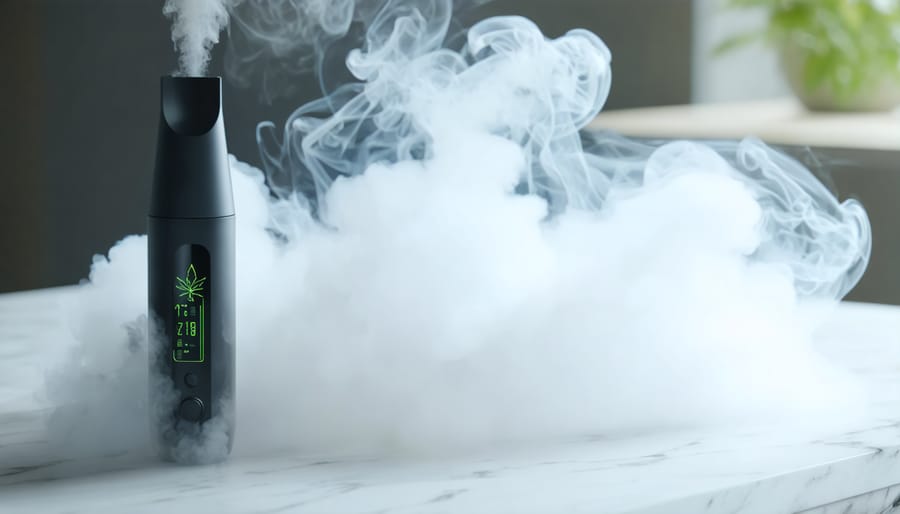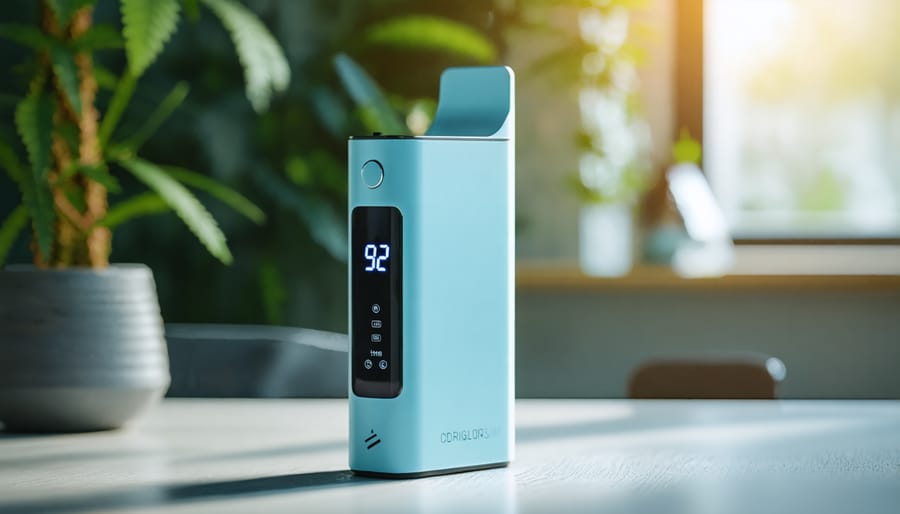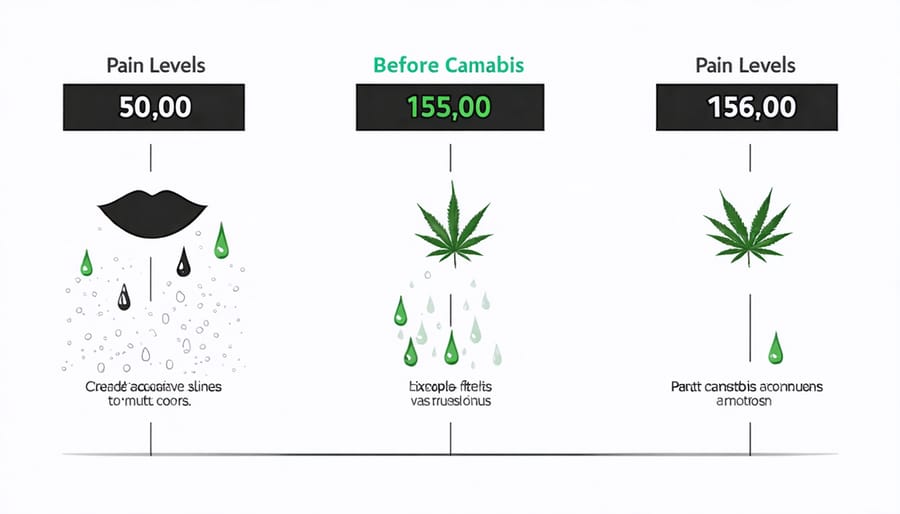
Cannabis Vaping: A Patient’s Path to Better Symptom Relief
Vaporizing cannabis delivers precise, therapeutic doses of cannabinoids while minimizing respiratory risks compared to traditional smoking methods. Unlike a mango flavoured vape, medical cannabis vaporization releases active compounds at controlled temperatures, optimizing bioavailability for conditions ranging from chronic pain to anxiety. Recent clinical studies demonstrate that vaporized cannabis provides rapid symptom relief while allowing patients to fine-tune their dosage with greater accuracy than edibles or tinctures. Healthcare providers increasingly recommend vaporization as a preferred delivery method for medical cannabis patients, citing better dose control, reduced exposure to combustion byproducts, and improved therapeutic outcomes. This evidence-based approach to cannabis administration represents a significant advancement in how patients can safely and effectively manage their symptoms using plant-based medicine.
How Cannabis Vaping Delivers Therapeutic Benefits

Temperature Control and Cannabinoid Activation
One of the most significant advantages of vaporizing cannabis concentrate is the precise temperature control it offers. Different cannabinoids and terpenes activate at specific temperatures, allowing patients to target particular therapeutic effects. For example, CBD begins to vaporize at around 320°F (160°C), while THC becomes active at approximately 315°F (157°C). This temperature control enables patients to customize their treatment experience. Lower temperatures (320-350°F) typically produce mild effects and emphasize the therapeutic properties of CBD and terpenes, which can help with anxiety and inflammation. Middle-range temperatures (350-390°F) activate more THC and other beneficial compounds, providing balanced relief for pain and muscle tension. Higher temperatures (390-430°F) release maximum compounds but should be approached cautiously as they can be more intense. Modern vaporizers feature digital temperature controls that maintain consistent heating, ensuring reliable dosing and preventing the harsh byproducts associated with combustion. This precision helps patients find their optimal therapeutic window while minimizing respiratory irritation.
Bioavailability Benefits
Vaporizing cannabis offers superior bioavailability compared to other consumption methods, making it a more efficient option for patients seeking therapeutic benefits. When cannabis is vaporized, the active compounds are absorbed directly through the lungs into the bloodstream, achieving an absorption rate of 30-60%. This is significantly higher than oral consumption, which typically only provides 10-20% bioavailability due to first-pass metabolism in the liver. The enhanced bioavailability through vaping means patients can achieve desired therapeutic effects with smaller doses of cannabis, potentially reducing both costs and unwanted side effects. The onset of effects is also much quicker, typically within 1-3 minutes, allowing patients to better manage acute symptoms and titrate their dosage more precisely. Temperature control in vaporizers further optimizes the extraction of specific cannabinoids and terpenes, enabling patients to target particular therapeutic benefits while avoiding the harmful byproducts associated with combustion. This precise delivery system ensures that patients receive consistent, predictable doses of their medicine, making it easier to maintain an effective treatment regimen.
Key Medical Benefits of Cannabis Vaping
Pain Management
Vaping cannabis has emerged as an effective method for managing chronic pain conditions, offering quick relief with precise dosage control. Studies have shown that vaporized cannabinoids can provide significant pain reduction while minimizing the respiratory risks associated with smoking. Research into cannabis for pain relief indicates that THC and CBD work together through the endocannabinoid system to reduce inflammation and alter pain perception. Patients report that vaping cannabis provides faster onset of pain relief compared to other consumption methods, typically within 5-10 minutes. This rapid action makes it particularly valuable for breakthrough pain management. The ability to control temperature settings in vaporizers also allows users to target specific cannabinoids and terpenes that are most effective for their pain conditions. For those managing chronic conditions like fibromyalgia, arthritis, or neuropathic pain, vaping can be particularly beneficial as it allows for multiple small doses throughout the day without the harmful effects of combustion. This method also helps maintain consistent pain relief levels while minimizing potential side effects.

Anxiety and Stress Relief
Cannabis vaping has shown promising results in managing anxiety and stress-related conditions, offering rapid relief through controlled dosing. When cannabinoids are inhaled through vaporization, they interact with the body’s endocannabinoid system, which plays a crucial role in regulating mood and stress responses. Many patients report experiencing a calming effect within minutes of vaping cannabis, particularly strains rich in CBD and specific terpenes like linalool and myrcene. This quick onset makes it particularly effective for managing acute anxiety episodes and sudden stress spikes. The ability to microdose through vaping allows users to find their optimal therapeutic level without overwhelming effects. Research suggests that vaporized cannabis may help reduce cortisol levels, the body’s primary stress hormone, while promoting the release of mood-stabilizing neurotransmitters. Users often experience improved sleep quality and reduced racing thoughts, contributing to better overall mental wellness. However, it’s essential to work with healthcare providers to determine appropriate strains and dosing schedules, as individual responses can vary significantly. Starting with low doses and gradually adjusting based on personal needs typically yields the best results for anxiety management.
Sleep Enhancement
Research suggests that vaporized cannabis can significantly improve both sleep quality and duration for individuals struggling with insomnia and sleep-related issues. Studies have shown that specific cannabinoids, particularly THC and CBN, may help reduce the time it takes to fall asleep and increase overall sleep duration. The relationship between cannabis and sleep quality is particularly notable when using indica-dominant strains through vaporization, as this method allows for precise dosing and quick onset of effects. Vaping cannabis before bedtime may help regulate sleep-wake cycles and reduce sleep disturbances, especially in patients dealing with chronic pain, anxiety, or PTSD-related sleep issues. The controlled delivery of cannabinoids through vaporization can provide more consistent results compared to other consumption methods, helping users maintain healthy sleep patterns without the respiratory concerns associated with smoking. For optimal sleep benefits, many patients report success with low-temperature vaporization about an hour before bedtime, allowing the calming effects to gradually transition them into restful sleep. It’s important to work with a healthcare provider to determine appropriate timing and dosing for individual sleep needs.
Nausea Control
Cannabis vaping has shown significant promise in managing nausea and vomiting, particularly for patients undergoing chemotherapy and other intensive medical treatments. Studies indicate that vaporized cannabis can provide rapid relief from nausea symptoms, often within minutes of administration, making it an valuable option for patients who struggle to keep oral medications down. The cannabinoids in vaporized cannabis, particularly THC and CBD, interact with the body’s endocannabinoid system to regulate nausea responses in the brain and digestive system. For cancer patients, this can mean the difference between completing their prescribed treatment regimen and having to pause therapy due to severe nausea and vomiting. Many patients report that vaping cannabis offers better control over dosing compared to other consumption methods, allowing them to take small, measured amounts as needed throughout their treatment day. This precise control helps prevent overconsumption while maintaining consistent symptom relief. Additionally, the lack of combustion in vaping means patients can avoid the harsh smoke that might further aggravate their sensitive stomach during treatment. Healthcare providers increasingly recognize vaporized cannabis as a complementary therapy alongside traditional antiemetic medications, especially for patients who haven’t responded well to conventional treatments alone.
Safety Considerations and Best Practices
Choosing Quality Products
When selecting vaping products for therapeutic use, quality and safety should be your top priorities. Start by exploring various cannabis product options from licensed medical dispensaries or approved providers. Look for products that include detailed lab testing results, which should indicate cannabinoid content and confirm the absence of harmful contaminants like pesticides, heavy metals, and residual solvents. Choose vaporizers specifically designed for medical cannabis use, preferably those with temperature control features. Medical-grade devices often come with certifications from regulatory bodies and are made from high-quality, heat-resistant materials like ceramic, glass, or medical-grade stainless steel. Pay attention to the extraction methods used in vape cartridges. CO2 extraction is generally considered one of the safest methods, producing clean concentrates without harmful residues. Avoid products containing artificial flavors, cutting agents, or unnecessary additives, as these may compromise the therapeutic benefits and potentially cause adverse effects. For optimal results, select products with clearly labeled cannabinoid profiles that match your therapeutic needs. Full-spectrum extracts often provide enhanced benefits due to the entourage effect, while isolated compounds may be preferred for specific conditions. Always consult with your healthcare provider about which products best suit your treatment plan and medical requirements.
Proper Usage Guidelines
For optimal therapeutic benefits from cannabis vaping, start with a low dose and gradually increase it until you achieve the desired effects. This approach, known as “start low, go slow,” helps minimize potential side effects while finding your ideal therapeutic dose. Begin with one or two small inhalations and wait 10-15 minutes to assess the effects before taking additional doses. Different cannabis strains and compositions may require different dosing strategies, so maintain a journal to track your responses to various products and doses. Temperature control is crucial for therapeutic vaping. Lower temperatures (320-356°F/160-180°C) generally produce milder effects and preserve more terpenes, while higher temperatures (356-392°F/180-200°C) may provide stronger effects but could increase throat irritation. Time your doses according to your symptoms and daily routine. Morning doses might be preferable for pain management or nausea control, while evening doses may better serve sleep-related issues. Always vape in a well-ventilated area and keep your device clean and properly maintained. For chronic conditions, establish a consistent dosing schedule in consultation with your healthcare provider. Be mindful of your body’s responses and adjust accordingly. Remember that tolerance can develop over time, so periodic breaks may help maintain effectiveness. Store your cannabis and vaping equipment in a cool, dark place away from direct sunlight and heat. Always use lab-tested products from licensed providers to ensure safety and consistency in your therapeutic regimen.
Patient Considerations and Support

Working with Healthcare Providers
Open communication with your healthcare provider is essential when considering cannabis vaping for therapeutic purposes. Start by being honest about your interest in cannabis vaping and any current cannabis use. Many healthcare providers are becoming increasingly knowledgeable about medical cannabis and can offer valuable guidance based on your specific condition. When discussing cannabis vaping with your doctor, come prepared with questions about potential benefits, risks, and interactions with your current medications. Keep a symptom journal documenting your health concerns and previous treatments to help facilitate a productive conversation. This information helps your healthcare provider make informed recommendations about whether cannabis vaping might be appropriate for your situation. If your primary healthcare provider isn’t comfortable discussing cannabis therapy, consider seeking a consultation with a cannabis-specialized physician or clinic. These professionals often have extensive experience in recommending medical cannabis and can provide detailed guidance on strains, dosing, and vaping techniques. Remember to regularly update your healthcare team about your cannabis use, including any benefits or side effects you experience. This ongoing dialogue helps ensure your treatment plan remains safe and effective. Many providers appreciate patients who take an active role in their healthcare decisions while remaining transparent about their therapeutic choices. Building a collaborative relationship with your healthcare provider creates a supportive environment for exploring cannabis vaping as part of your treatment plan. Their medical expertise, combined with your personal health goals, can help determine the most appropriate approach to incorporating cannabis vaping into your therapeutic routine.
Monitoring Treatment Progress
Monitoring your cannabis vaping treatment is essential for achieving optimal therapeutic benefits. Start by maintaining a detailed journal to track your usage patterns, including dosage, frequency, and specific cannabis strains used. Note the effects experienced, both positive and negative, along with the timing and duration of these effects. Pay attention to changes in your symptoms and overall well-being. Record any improvements in your primary condition, as well as any secondary benefits or side effects. Consider using a numerical scale (1-10) to rate symptom severity before and after vaping sessions, making it easier to identify patterns and effectiveness. Regular check-ins with your healthcare provider are crucial for adjusting your treatment plan. Share your journal entries during these appointments to help inform any necessary modifications to your dosing schedule or strain selection. Many patients find it helpful to document the temperature settings used during vaping sessions, as different temperatures can affect the release of various therapeutic compounds. Use mobile apps or simple spreadsheets to track your cannabis medicine expenses and monitor your supply. This can help you maintain consistent access to your medication and better understand your monthly needs. Remember that individual responses to cannabis can vary, and finding the right balance may require patience and careful adjustment over time. If you notice any concerning patterns or side effects, consult with your healthcare provider promptly to make appropriate adjustments to your treatment plan. Cannabis vaping offers promising therapeutic benefits for various medical conditions, providing patients with a potentially safer alternative to traditional smoking methods. Throughout this article, we’ve explored how vaporization can deliver precise dosing, rapid onset of effects, and reduced respiratory risks compared to combustion methods. However, it’s crucial to remember that every patient’s needs are unique, and the effectiveness of cannabis vaping can vary significantly between individuals. Always consult with a qualified healthcare provider before starting any cannabis treatment program, as they can help determine appropriate dosing, strain selection, and vaping methods based on your specific condition and medical history. By combining proper medical guidance with the therapeutic potential of cannabis vaping, patients can work towards achieving optimal results while maintaining their safety and well-being.
